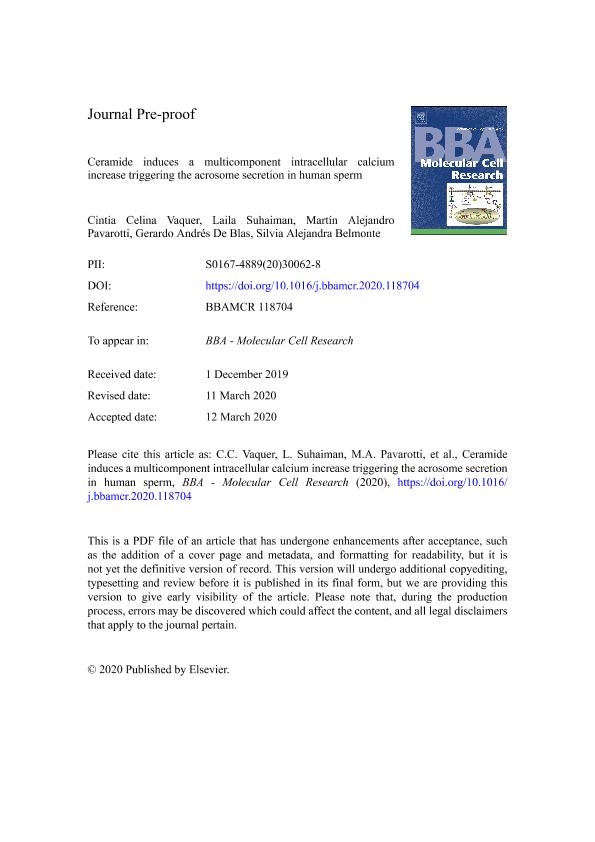Mostrar el registro sencillo del ítem
dc.contributor.author
Vaquer, Cintia Celina

dc.contributor.author
Suhaiman, Laila

dc.contributor.author
Pavarotti, Martin Alejandro

dc.contributor.author
de Blas, Gerardo Andrés

dc.contributor.author
Belmonte, Silvia Alejandra

dc.date.available
2021-09-20T17:33:23Z
dc.date.issued
2020-07
dc.identifier.citation
Vaquer, Cintia Celina; Suhaiman, Laila; Pavarotti, Martin Alejandro; de Blas, Gerardo Andrés; Belmonte, Silvia Alejandra; Ceramide induces a multicomponent intracellular calcium increase triggering the acrosome secretion in human sperm; Elsevier Science; Biochimica et Biophysica Acta-Molecular Cell Research; 1867; 7; 7-2020; 1-76
dc.identifier.issn
0167-4889
dc.identifier.uri
http://hdl.handle.net/11336/140902
dc.description.abstract
Exocytosis of spermatozoon's secretory vesicle, named acrosome reaction (AR), is a regulated event that plays a central role in fertilization. It is coupled to a complex calcium signaling. Ceramide is a multitasking lipid involved in exocytosis. Nevertheless, its effect on secretion is controversial and the underlying cellular and molecular mechanisms remain unknown. Human spermatozoa are useful to dissect the role of ceramide in secretion given that the gamete is not capable to undergo any trafficking mechanisms other than exocytosis. We report for the first time, the presence of sphingolipid metabolism enzymes such as neutral-sphingomyelinase and ceramide synthase in sperm. Ceramidases are also present and active. Both the addition of cell-permeable ceramide and the rise of the endogenous one, increase intracellular calcium acting as potent inducers of exocytosis. Ceramide triggers AR in capacitated spermatozoa and enhances the gamete response to progesterone. The lipid induces physiological ultrastructural changes in the acrosome and triggers an exocytosis-signaling cascade involving protein tyrosine phosphatase 1B and VAMP2. Real-time imaging showed an increment of calcium in the cytosol upon ceramide treatment either in the absence or in the presence of extracellular calcium. Pharmacological experiments demonstrate that at early stages the process involves ryanodine receptors, CatSper (calcium channel of sperm), and store-operated calcium channels. We set out the signaling sequence of events that connect ceramide to internal calcium mobilization and external calcium signals during secretion. These results allow the coordination of lipids and proteins in a pathway that accomplishes secretion. Our findings contribute to the understanding of ceramide's role in regulated exocytosis and fertilization.
dc.format
application/pdf
dc.language.iso
eng
dc.publisher
Elsevier Science

dc.rights
info:eu-repo/semantics/openAccess
dc.rights.uri
https://creativecommons.org/licenses/by-nc-sa/2.5/ar/
dc.subject
ACROSOME REACTION
dc.subject
CALCIUM
dc.subject
CERAMIDE
dc.subject
EXOCYTOSIS
dc.subject
LIPID SIGNALING
dc.subject
SPERM
dc.subject.classification
Bioquímica y Biología Molecular

dc.subject.classification
Ciencias Biológicas

dc.subject.classification
CIENCIAS NATURALES Y EXACTAS

dc.title
Ceramide induces a multicomponent intracellular calcium increase triggering the acrosome secretion in human sperm
dc.type
info:eu-repo/semantics/article
dc.type
info:ar-repo/semantics/artículo
dc.type
info:eu-repo/semantics/publishedVersion
dc.date.updated
2021-08-25T19:29:22Z
dc.journal.volume
1867
dc.journal.number
7
dc.journal.pagination
1-76
dc.journal.pais
Países Bajos

dc.journal.ciudad
Amsterdam
dc.description.fil
Fil: Vaquer, Cintia Celina. Consejo Nacional de Investigaciones Científicas y Técnicas. Centro Científico Tecnológico Conicet - Mendoza. Instituto de Histología y Embriología de Mendoza Dr. Mario H. Burgos. Universidad Nacional de Cuyo. Facultad de Ciencias Médicas. Instituto de Histología y Embriología de Mendoza Dr. Mario H. Burgos; Argentina
dc.description.fil
Fil: Suhaiman, Laila. Consejo Nacional de Investigaciones Científicas y Técnicas. Centro Científico Tecnológico Conicet - Mendoza. Instituto Interdisciplinario de Ciencias Básicas. - Universidad Nacional de Cuyo. Instituto Interdisciplinario de Ciencias Básicas; Argentina
dc.description.fil
Fil: Pavarotti, Martin Alejandro. Consejo Nacional de Investigaciones Científicas y Técnicas. Centro Científico Tecnológico Conicet - Mendoza. Instituto de Histología y Embriología de Mendoza Dr. Mario H. Burgos. Universidad Nacional de Cuyo. Facultad de Ciencias Médicas. Instituto de Histología y Embriología de Mendoza Dr. Mario H. Burgos; Argentina
dc.description.fil
Fil: de Blas, Gerardo Andrés. Consejo Nacional de Investigaciones Científicas y Técnicas. Centro Científico Tecnológico Conicet - Mendoza. Instituto de Histología y Embriología de Mendoza Dr. Mario H. Burgos. Universidad Nacional de Cuyo. Facultad de Ciencias Médicas. Instituto de Histología y Embriología de Mendoza Dr. Mario H. Burgos; Argentina
dc.description.fil
Fil: Belmonte, Silvia Alejandra. Consejo Nacional de Investigaciones Científicas y Técnicas. Centro Científico Tecnológico Conicet - Mendoza. Instituto de Histología y Embriología de Mendoza Dr. Mario H. Burgos. Universidad Nacional de Cuyo. Facultad de Ciencias Médicas. Instituto de Histología y Embriología de Mendoza Dr. Mario H. Burgos; Argentina
dc.journal.title
Biochimica et Biophysica Acta-Molecular Cell Research

dc.relation.alternativeid
info:eu-repo/semantics/altIdentifier/url/https://linkinghub.elsevier.com/retrieve/pii/S0167488920300628
dc.relation.alternativeid
info:eu-repo/semantics/altIdentifier/doi/http://dx.doi.org/10.1016/j.bbamcr.2020.118704
Archivos asociados
